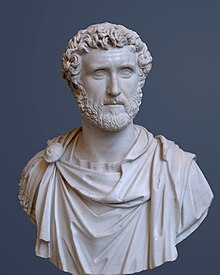
Back Antoninus Pius Afrikaans Antoninus Pius ALS Antonín Pío AN أنطونيوس بيوس Arabic انطونينوس بيوس ARZ Antonín Píu AST Antonin Piy Azerbaijani آنتونیوس پیوس AZB Антанін Пій Byelorussian Антонин Пий Bulgarian
| Antoninus Pius | |||||||||
|---|---|---|---|---|---|---|---|---|---|
 Bust in the Glyptothek, Munich | |||||||||
| Roman emperor | |||||||||
| Reign | 11 July 138 – 7 March 161 | ||||||||
| Predecessor | Hadrian | ||||||||
| Successor | Marcus Aurelius and Lucius Verus | ||||||||
| Born | Titus Aurelius Fulvus Boionius Antoninus[1] 19 September 86 Lanuvium, Italy | ||||||||
| Died | 7 March 161 (aged 74) Lorium, Italy | ||||||||
| Burial | |||||||||
| Spouse | Annia Galeria Faustina | ||||||||
| Issue Detail |
| ||||||||
| |||||||||
| Dynasty | Nerva–Antonine | ||||||||
| Father |
| ||||||||
| Mother |
| ||||||||

| Roman imperial dynasties | ||||||||||||||
|---|---|---|---|---|---|---|---|---|---|---|---|---|---|---|
| Nerva–Antonine dynasty (AD 96–192) | ||||||||||||||
| Chronology | ||||||||||||||
|
||||||||||||||
| Family | ||||||||||||||
| Succession | ||||||||||||||
|
||||||||||||||
Titus Aelius Hadrianus Antoninus Pius (19 September AD 86 – 7 March 161) was Roman emperor from AD 138 to 161. He was the fourth of the Five Good Emperors from the Nerva–Antonine dynasty.[3]
Born into a senatorial family, Antoninus held various offices during the reign of Emperor Hadrian. He married Hadrian's niece Faustina, and Hadrian adopted him as his son and successor shortly before his death. Antoninus acquired the cognomen Pius after his accession to the throne, either because he compelled the Senate to deify his adoptive father,[4] or because he had saved senators sentenced to death by Hadrian in his later years.[5] His reign is notable for the peaceful state of the Empire, with no major revolts or military incursions during this time. A successful military campaign in southern Scotland early in his reign resulted in the construction of the Antonine Wall.
Antoninus was an effective administrator, leaving his successors a large surplus in the treasury, expanding free access to drinking water throughout the Empire, encouraging legal conformity, and facilitating the enfranchisement of freed slaves. He died of illness in AD 161 and was succeeded by his adopted sons Marcus Aurelius and Lucius Verus as co-emperors.
- ^ Salomies, O (2014). "Adoptive and Polyonymous Nomenclature in the Roman Empire – Some Addenda". In Caldelli, M. L.; Gregori, G. L. (eds.). Epigrafia e ordine senatorio, 30 anni dopo. Edizioni Quasar. pp. 492–493. ISBN 9788871405674.
- ^ a b Cooley, Alison E. (2012). The Cambridge Manual of Latin Epigraphy. Cambridge University Press. pp. 492–493. ISBN 978-0-521-84026-2.
- ^ Bowman 2000, p. 150.
- ^ Birley 2000, p. 54; Dio, 70:1:2.
- ^ Birley 2000, p. 55; citing the Historia Augusta, Life of Hadrian 24.4.
© MMXXIII Rich X Search. We shall prevail. All rights reserved. Rich X Search